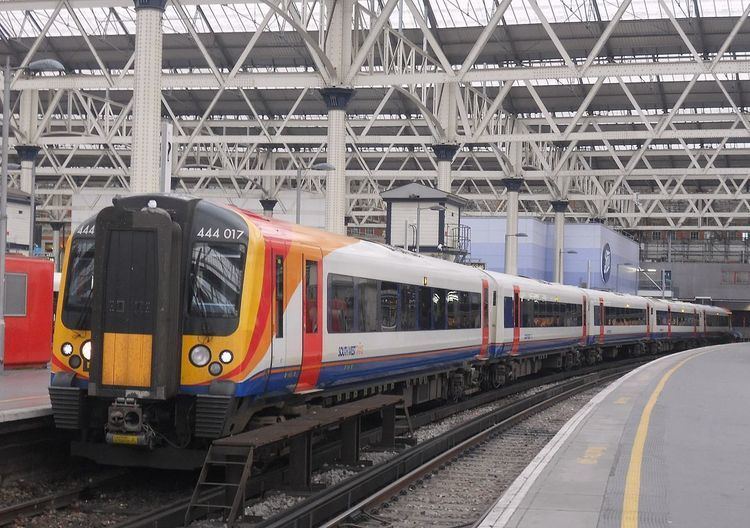Manufacturer Siemens AG | Number built 45 trainsets | |
 | ||
In service 21 April 2004 - Current Replaced Class 442Class 423Class 421Class 411Class 412 | ||
Class 444 Desiro electric multiple-unit trains were built in Austria by Siemens AG in 2002-04 for use in Britain on express passenger services operated by South West Trains (SWT). These 45 units form SWT's main long-distance fleet.
Contents
The Siemens "Desiro UK" family also includes units of Classes 185, 350, 360, 380, and 450.
Description
At the start of the 21st century, as part of its franchise agreement, SWT was required to replace the old life-expired slam-door rolling stock of Classes 411, 412, 421 and 423, which did not meet modern health and safety standards, with new trains. In April 2001 an order was placed with Siemens for 785 vehicles. This was originally to be split as 100 four-car Class 450/0 outer-suburban units, 32 five-car Class 450/2 inner-suburban units, and 45 five-car Class 444 express units.
The Class 444 fleet was built at Siemens' Vienna plant. Before being shipped to Britain via the Channel Tunnel, the trains were extensively tested on the test-track at Wildenrath. This was an attempt to reduce the time taken for new trains to enter service, by ironing out any problems beforehand. Many other designs of new train, such as the Alstom Class 458 units, had been plagued by problems and poor reliability. The Desiro fleet entered service faster than its competitors, but still suffered teething problems.
The trains are formed of five coaches, and are numbered in the range 444001-045. Each unit is formed of two outer driving motors, two intermediate trailers, and an intermediate buffet coach. The description of this formation is DMSO+TSO+TSO+TSRMB+DMCO. Individual vehicles are numbered as follows.
The units have end-gangways, allowing passengers to move between units when used in multiple. Trains are limited to a 10-coach length (i.e. two units), as longer trains cannot be accommodated in stations. At some stations with particularly short platforms (for example Shawford, in Hampshire), even a single unit of five coaches is too long for the platform. Passengers used to have to board and alight via a single door opened by the guard, however, since the introduction of automatic selective door operation (ASDO) in early 2015, the computer system works out how many coaches to release the doors on. The fleet is painted in SWT's express livery of white, with a blue window band, and red/orange swishes at the cab ends.
Each five-car unit has a first-class section taking up just over half of one car at one end. First-class seats have BS 1363 sockets providing AC power for laptops or mobile phone charges, while the car at the other end is standard-class throughout and appears ordinary but has BS1363 sockets under the tables.
Like all new-build third-rail rolling stock in the UK, one coach in each unit is fitted with a recess for a pantograph. This allows for a future conversion to AC overhead power, although at present no trains in this fleet have been so fitted.
All sets are based at the purpose-built Siemens depot at Northam, Southampton.
A new variable-stiffness hydraulic bush is being fitted to the whole Class 444 fleet so as to reduce track damage and thus infrastructure maintenance costs. This work was scheduled to be completed by the end of 2013.
Awards
Class 444 trains have been awarded the "Golden Spanner 2010" as Britain's most reliable trains by Modern Railways. During twelve months, SWT's fleet has set a new reliability record of almost 89,000 kilometres per technical delay.
Operations
The first Class 444 units entered service with SWT in early 2004. As part of the launch, unit no. 444018 was named "The Fab 444" at a ceremony at London Waterloo.
The units were introduced on services from London Waterloo to Portsmouth Harbour via the Portsmouth Direct Line. They were also used on some services on the South Western Main Line to Southampton Central, Bournemouth, Weymouth and on limited outer suburban services to Alton and Basingstoke. This allowed the withdrawal of the final 4Cep units by mid-2004, and inroads were made to the 4Bep, 4Cig and 4Vep fleets.
It was originally hoped that the final slam-door trains would be withdrawn by the end of 2004. In the event, some were allowed to remain operational until May 2005 as the last replacement Desiros came into service. Initially, the Class 444s were used mainly on Portsmouth direct services, allowing the Wessex Electric units to be used on the Weymouth line. The Class 444 units were also used regularly on Sunday-only Bournemouth stopping services, Waterloo to Southampton services and the Brockenhurst to Wareham shuttle service. Previous power limitations meant that the trains were not permitted to run west of Poole; these restrictions have since been lifted.
During 2007, the Class 444 units replaced the Wessex Electrics (Class 442) on the Weymouth line. Some Class 442 workings were taken over by Class 444s as early as November 2006; the final Class 442 was withdrawn in February 2007. Class 444s transferred to the Weymouth line were replaced on Portsmouth services by Class 450 Desiros which became available after the reintroduction of the Class 458 units on the Waterloo to Reading line. The decision to transfer many 444s units to the Weymouth line was not popular. Portsmouth line passengers protested over the use of class 450s on some services, while there were complaints that the 444s were inferior to the units they replaced on the Weymouth line.
Class 444s are currently used on the following services:
In June 2007 it was reported in the Ipswich Evening Star that Network Rail's Greater Anglia area Rail Utilisation Strategy was suggesting the possibility of introducing a train based on the class 444 on the London - Ipswich - Norwich line.
Named units
Named units are as follows:
